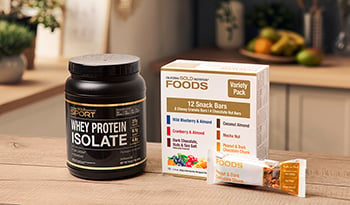11 Healthy Snacking Tips for Managing Weight and Hunger
DISCLAIMER:This blog does not intend to provide diagnosis...
- In this article:
- 1. Be Mindful of Body Cues
- 2. Rate Level of Hunger for Weight Management
- 3. Consider Your Next Meal Before Starting Any Healthy Snacking
- 4. Consider What Sounds Good and Be Mindful of Cravings
- 5. Choose a Combination of Whole Foods
- 6. Focus on the Food During Healthy Snacking Sessions
- 7. Take Small Bites of Whole Foods
- 8. Use Portion Control for Healthy Snacking
- 9. Take a Mindful Break in the Middle
- 10. Savor the Taste, Texture and Smell of Whole Foods
- 11. Make Healthy Snacking a Pleasurable Experience

Learn how to gauge hunger and pay attention to physical body cues before raiding the snack cabinet. When looking for a healthy snack to eat, find out why whole foods and certain combinations of foods are better for weight management and a sense of satisfaction.
1. Be Mindful of Body Cues
The first step of being mindful when snacking is to pay attention to body cues. It is possible for the brain to misinterpret other problems for hunger. For example, fatigue could be related to a lack of sleep, coming down with a cold or recovering from strenuous activity like exercise. The brain could easily interpret tiredness as hunger.
Stress, boredom and depression can also be misinterpreted as hunger by the brain. Before reaching for a snack, pay attention to cues sent by the body.
2. Rate Level of Hunger for Weight Management
A snack might only seem like a little bit of food, but the calories can add up, especially if your goal is weight loss. Before grabbing a bag out of the cupboard or pushing buttons on a vending machine, stop and rate your hunger level first.
A twinge of hunger might be satisfied with a glass of water or a cup of herbal tea. A moderate level of hunger may justify a small, 100-calorie snack. A lot of hunger suggests that the previous meal was nutritionally inadequate or lacked the right combination of whole foods. For example, a meal that is heavy in simple carbohydrates and low in protein and fiber could make a person feel famished again in just an hour or two.
3. Consider Your Next Meal Before Starting Any Healthy Snacking
Take a look at the clock. If your next meal is likely to be in an hour, a snack might not be necessary. Also, consider what your next meal will include.
For example, if your next meal is slated to be something hearty like a bowl of chili, healthy snacking before that meal might include whole foods with an emphasis on fruits and vegetables. Since chili may not include a serving of fruits or vegetables, you might want to have a small snack of almonds and a mandarin orange or a slice of whole-grain toast topped with almond butter and blueberries.
If your next meal is slated to be a veggie-heavy salad, it would be a good idea to choose a snack with protein and polyunsaturated fat. Some good snack options would include a handful of mixed nuts, an ounce of jerky or a tablespoon of peanut butter on a couple of whole-grain crackers.
4. Consider What Sounds Good and Be Mindful of Cravings
An intense sweet craving in the late afternoon could disrupt healthy choices made during the day. Before engaging in healthy snacking, think about what sounds good or what the body is craving.
Some people have a tendency to crave salty snacks while others go for savory or sweet snacks. Fortunately, there are whole foods that can satisfy any type of craving. Try cacao blended into almond butter or added into a fruit smoothie to satisfy a chocolate craving.
A salt craving could be relieved by roasting raw almonds with sea salt and pepper or other spices. Quinoa with ghee butter and diced vegetables could satisfy a craving for savory food.
5. Choose a Combination of Whole Foods
Although a snack is meant to tie one over between meals and prevent overeating at the next planned meal, it should not be too dense in calories. An ideal snack should be about 100 calories and contain two or more types of whole foods or minimally processed foods.
For example, slicing a small banana in half and spreading one tablespoon of almond butter on one of the halves would provide about 100 calories. This combination includes polyunsaturated fat, protein and complex carbohydrates. Bone broth with diced celery, onions and a handful of quinoa is healthier than instant soup packets and provides fiber, calcium and protein. Whole fruits and vegetables also provide soluble and insoluble fiber, which make a person feel full for a longer period of time. The presence of fiber helps the body process the natural sugar in fruits, which stabilizes blood sugar levels.
6. Focus on the Food During Healthy Snacking Sessions
Part of being mindful about snacking includes focusing on the food when eating. Even if it is just a quick snack, put away any distractions. Put your phone away, turn off the television or computer monitor, lower the volume of music and be present in the current moment.
Before taking that first bite, take a second to clear unwanted thoughts from the mind. Let the food be the focus of the thoughts. A five-minute break for healthy snacking can also be a good way to take a mental and emotional break from a stressful or busy day.
7. Take Small Bites of Whole Foods
When a person is in a hurry, it can be tempting to take huge bites in order to finish the snack faster. Taking big bites makes it more difficult to chew and taste the food. Swallowing big bites of food could be painful. Slow down and take smaller bites.
When enjoying whole foods like apples or grapes, consider slicing them beforehand. An apple corer is a convenient tool to make this easier.
8. Use Portion Control for Healthy Snacking
Many people are surprised to look at food packaging and discover that the candy bar actually had two servings, not just one. That 20-ounce soda was 2.5 servings. Whenever possible, use portion control when preparing healthy snacks.
When purchasing a bag of almonds or granola, use kitchen measuring cups and portion snacks into small glass containers, plastic storage bowls or reusable food storage bags. These containers can then be placed in a convenient spot. With one serving already measured, it will be more difficult to overeat during the snacking session.
9. Take a Mindful Break in the Middle
Halfway through eating a healthy snack, stop for a minute. It is possible that the amount of food that has already been consumed is sufficient to satisfy the hunger for a while. If this is the case, the remainder of the snack can be saved for another time.
A good habit for this break in the middle of a healthy snacking session is to drink half a glass of water. After the snacking session concludes, drink the rest of the glass of water. The water helps with the digestive process.
10. Savor the Taste, Texture and Smell of Whole Foods
A person should engage all of their senses when enjoying a snack. Before taking that first bite of an apple, smell it. Feel its skin. Admire its color and shape. A lot of the experience of eating is the smell of the food.
When a person has a cold or stuffy nose, they often have a decreased appetite because they cannot smell the food. When the nose and sinuses are stuffy and clogged, food may not taste quite right. Slow down and savor the smell, texture and taste of each bite of the snack.
One tip for weight management is to try to eat slowly and make it easier for the body to recognize that it is full. This could help prevent overeating a snack or meal.
11. Make Healthy Snacking a Pleasurable Experience
Many people have to eat on the run. They might eat a snack bar while driving to work or running to catch their bus or train. They might have to hurry through lunch in order to get to a meeting on time, and dinner might be rushed because of evening errands or obligations.
Whenever possible, make healthy snacking and mealtimes a relaxing and pleasurable experience. Sit down to eat. Use a plate and put the nuts and fruit on it. Use silverware instead of disposable plastic.
At home, set a table with a placemat and napkin. Consider lighting a candle or adding some fresh flowers to the table. The pleasure of the experience slows down the eating process, which is beneficial to weight management.
Do not feel guilty about having a snack. Your nutritional goals should revolve around providing the right amounts of nutrients to the body and to enjoy the experience and benefits of eating healthy foods.




